Ginger bug recipe makes exciting homemade sodas and other carbonated drinks full of fizz and probiotics. Make ginger beer from scratch!

This post contains affiliate links, which means if you click through and make a purchase, I make a small commission at no extra cost to you. See my full disclosure here.
This article will introduce you to the ginger bug, a lively, fizzy creature that is the starter for my favorite homemade sodas, and you’ll learn how to make your own. It’s easy to make your own ginger bug from scratch, using just three ingredients and practicing a little patience. Once it’s going, you can brew fresh sodas like ginger beer and fizzy lemonade with your ginger bug every day! You’ll love making your own sodas from scratch! Let’s dive in!
If you like this, you’ll love
how to brew probiotic ginger beer, using your ginger bug
Probiotic Fermented Lemonade Soda, carbonated with this ginger bug
fermented ginger paste, preserve ginger and keep it handy year round
ginger switchel sports drink with electrolytes for hydration
how to grow your own ginger plant in the garden or in a pot indoors
The Excitement that comes with a bubbly brew!
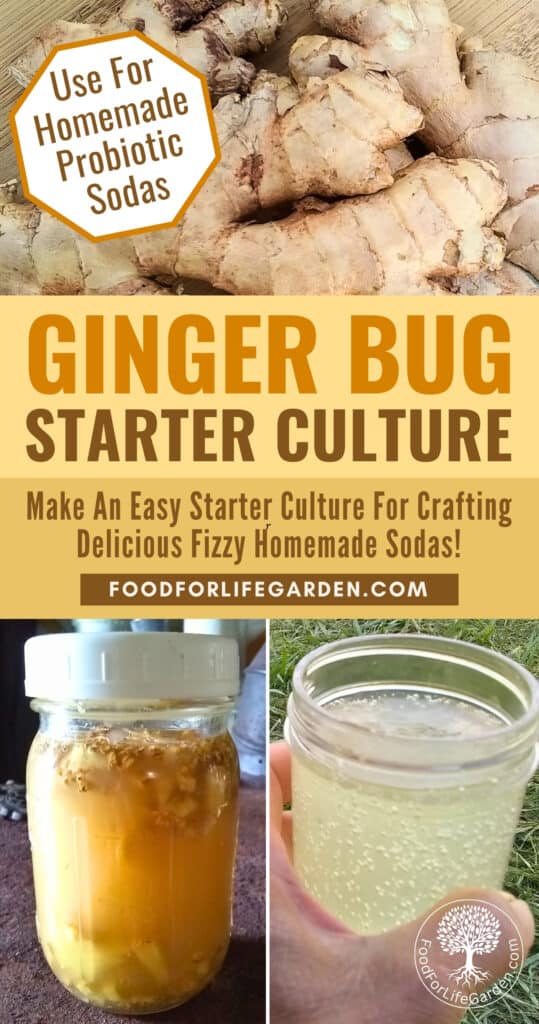
So honestly, for many years, I didn’t realize that you could make your own carbonated sodas. I had been fermenting and making wine and carbonated water kefir drinks. I had been planning to dabble in beer making for a while now, but I didn’t ever think about making soft drinks from scratch just with wild yeasts.
Maybe, that was because I was never interested in drinking soda, but a while back someone had me try a good brewed ginger beer, Reeds Premium Ginger Ale. I liked it a lot even though I found it a bit too sweet. But now that I knew of brewed ginger beer, my interest was piqued. This is something I could get to like if I could just get it less sweet.
As far a carbonated beverages go, Kombucha and water kefir have been my go to in the past, but you need the scobie or kefir grains for that. However there is a beast called a ginger bug, which can be created just with ginger, sugar and water, and she will make some pretty darn fizzy and super tasty sodas, once you make her come alive. How fun is that!
My ginger bug makes rocking ginger beer and a tasty and refreshing fizzy lemonade that are great on hot summer days.
Making a ginger bug and brewing your own soda is an age old technique from long before commercial soft drinks and it is a much different approach. Commercial sodas are just carbonated water and flavoring. This recipe, my friend, is the real deal and it is the most healthy type of soda you can make.
My friend Ginger

Now that I realize that soda can be healthy, low sugar and most of all, really tasty, ginger bug, named ‘Ginger’, has become my friend. And I have fresh brews fermenting all around my yurt all summer long. The hardest thing is to keep track of which ones need to be burped and which ones are ready to get chilled.
But it is oh so fun and oh so very tasty! I’ve mostly been making ginger beer and a few flavor versions thereof, but Ginger can put the fizz into anything that contains a little sugar. There she’ll eat the sugar for you so what you’re left with is all the healthy stuff, a lot of fizz, and none of the baddies.
Make the ginger bug your friend too!
When it’s hot out, and I mean, it gets hot around here, I can just sit here writing and I get drenched from dripping sweat as the temps climb to 100 degrees or higher. And working in the garden in this heat makes me more wet than standing in the rain for a while. So I realize that I need a lot of liquids and minerals to replenish what my body is losing in perspiration.
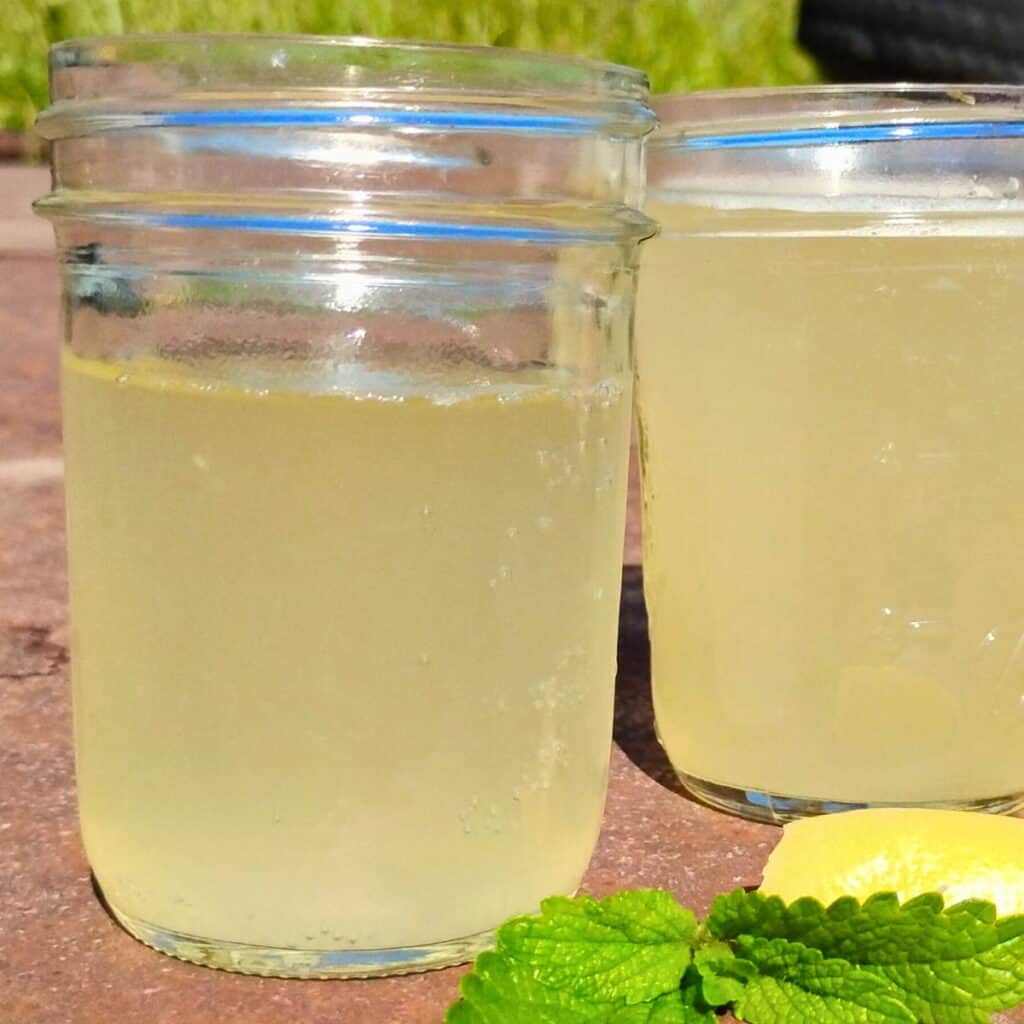
I often drink water with a dash of cider vinegar and a pinch of salt added, or, if I’m working hard outside, I love to make a switchel hydration drink, but my favorite on those relentlessly hot days is a bottle or two of ginger beer, icy cold from the fridge and refreshingly bubbly.
You should give ginger bug a try. I’m convinced that you’ll be captivated by her as well and that you’ll make her your best friend during times of hot weather.
It’s easy to make healthy sodas at home with the ginger bug recipe
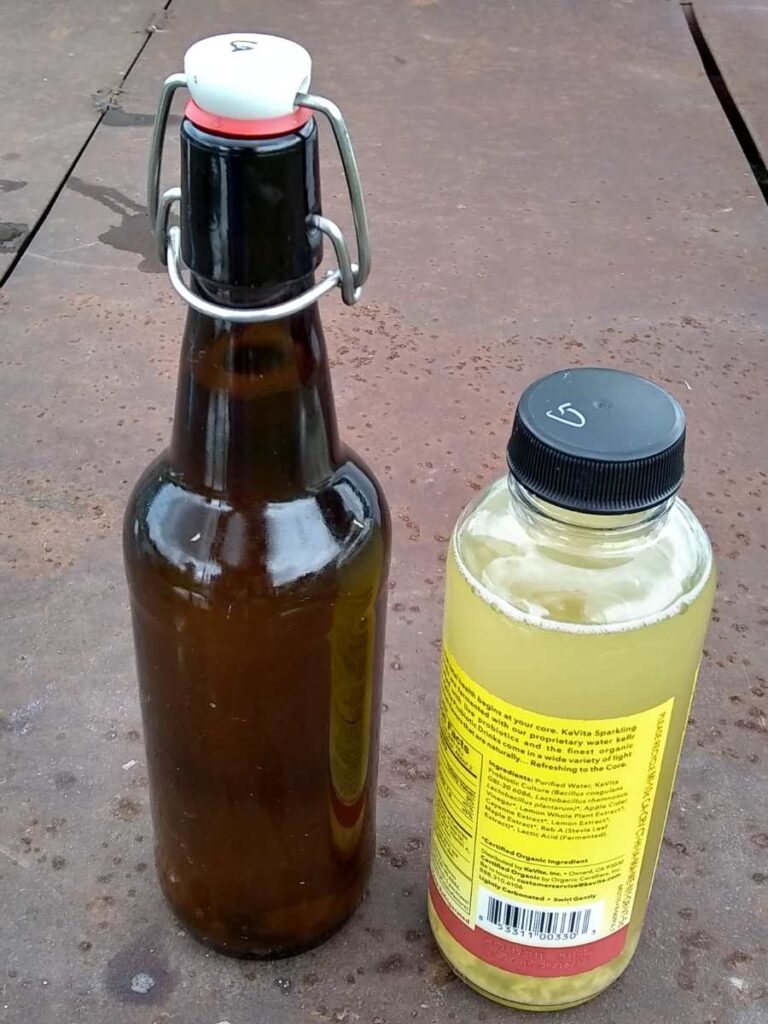
Making these sodas is so very easy that I am surprised it is not more commonly done. So let’s get the word out to people that frequent the soda aisles, and let them know that they can have the same thing but better, with little effort, and with healthy ingredients!
It is so easy to make and, in fact, this soda is actually better than good for you. It can add powerfully healthy benefits to your body and your gut. So it’s almost bad for your health, not to make this, and it’s definitely bad for your health to drink grocery aisle sodas, whether regular or ‘diet’. So if you have the habit, why not replace it with another that is going to benefit you in more ways than one.
Some of the benefits you get by making your own soda

You’re in control of the ingredients. You can make it super healthy depending on what you choose to put in it. Turn a bad thing (grocery aisle soft drinks) into a powerhouse for health.
Some benefits include getting gut healthy probiotics with your drink. The fermentation process adds lactic acid bacteria to your drink, which will enhance your gut microbiome and help with digestion and all sorts of gut ailments.
By choosing healthy sweeteners and using the process of fermentation, you can cut way down on sugar consumption without missing the sweetness. At the same time you’ll get the minerals and health benefits that come with whole and unrefined sweeteners.
With your choice of juices, tea, or flavored water, your ingredients can be full of healthy properties that can help with chronic disease, ailments and many health complaints. Check out all the health benefits of ginger beer. There is a long list of the proven health properties of ginger.
It’s so much fun to experiment with flavors and ingredients and you and your kids will love the results.
This is the traditional way of brewing soft drinks from long before they became commercialized. You will be taking part in keeping ancient traditions alive.
It’s super easy and quick to make. Less time than running to the store and picking out your high fructose, GMO soft drink that contains pesticides, is artificially flavored, colored and preserved. Blech!
How To make the ginger bug
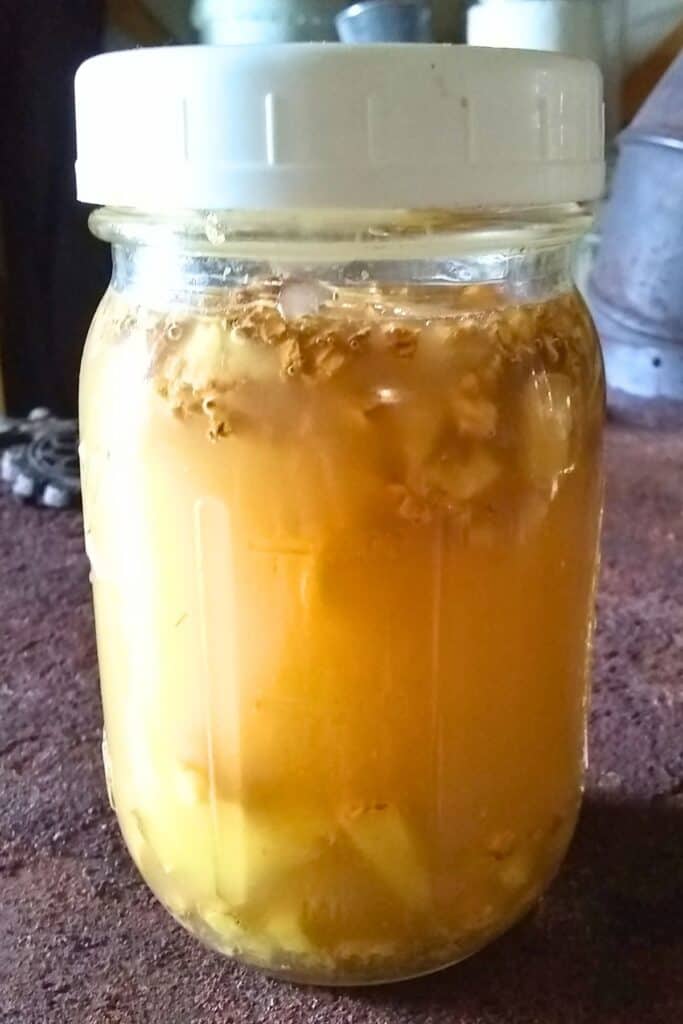
Equipment
Pint jar with lid – This will be ginger bug’s home. I use a pint canning jar with a plastic lid for convenience. And because the metal lids always react with fermented foods. I don’t care for that eroded metal flavor on the rim and on my hands when I handle it. Usually I try to use plastic as little as possible, but these lids are nice to have. Maybe someone can come up with some kind of inert material for this sort of thing. I’m keeping my eyes open for it.
Measuring teaspoon – You’ll be measuring the ginger and the sugar for starting the ginger bug and for feedings
Cutting board and knife – This is for cutting the ginger if you use fresh roots.
Pint or quart glass bottles or jars – What you will use to ferment your brew. One recipe for the ginger bug makes about 4 pints or 2 quarts. Choose heavy duty glass bottles for this, which are meant to hold up to some pressure, such as brewing bottles with swing tops, canning jars or used kombucha bottles, all with tight sealing lids. Do not use plastic.
Funnel and Strainer – For straining your ginger bug and teas, and for getting everything into the bottles without spillage.
Ingredients
Figuring out the ingredients is probably the most complicated part of making a ginger bug. Making her is not complicated at all. But understanding how the components work and why to choose what, is a bit difficult to sort out. Once you wrap your mind around all that, it’s easy-shmeezy.
Ginger root
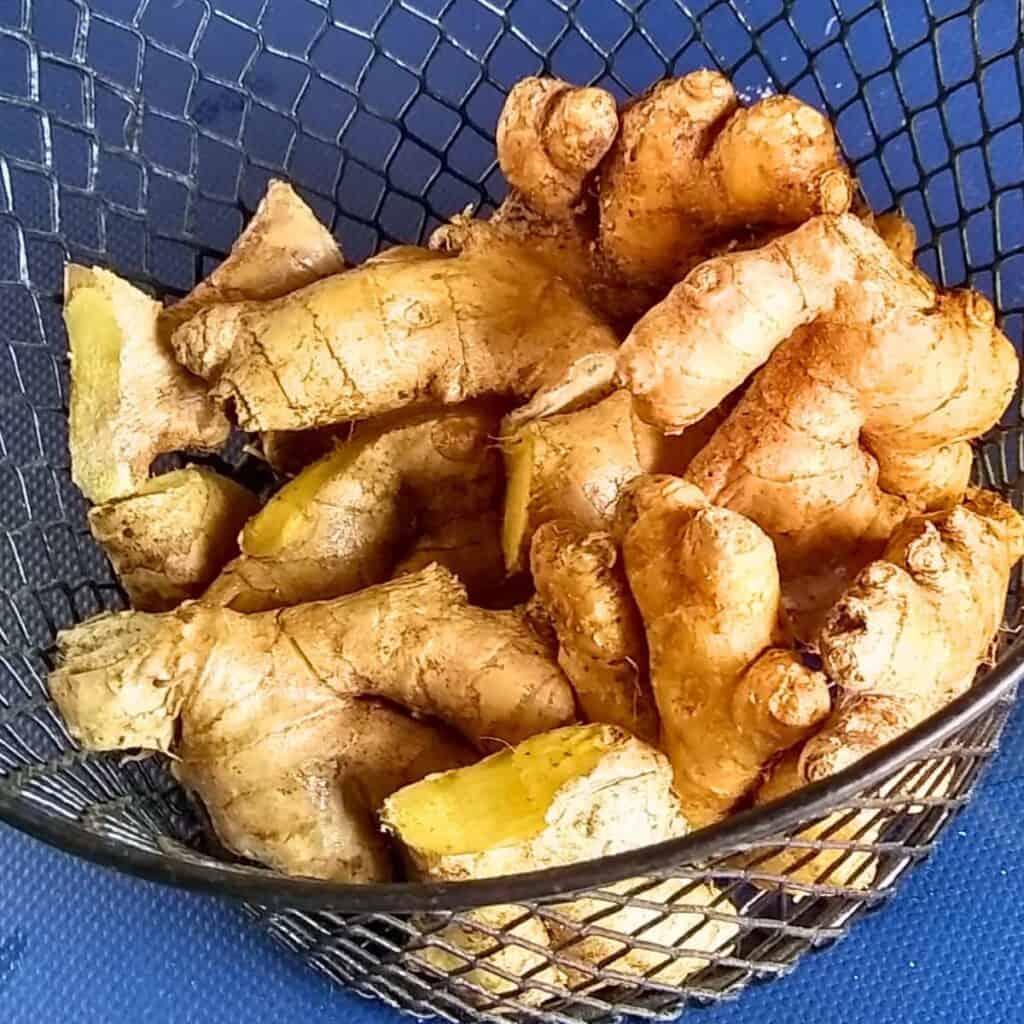
I prefer to use fresh roots for this. Fresh ginger roots contain the most health benefits when they are plump and juicy. You can keep them fresh in a moist paper bag in the fridge. Or in a paper bag on the counter for about a month, though it will start to dry up after a while. In my experience, they don’t like being in the refrigerator too long. Most of the time they get moldy on me. If they start to sprout, plant them in some dirt and grow your own.

The reason I like to use fresh roots is because the phenols and other active ingredients in the ginger are stronger in fresh roots. If you keep them on the counter for a while they will dry out and the oils will get less potent. If you get the dried root, it will have lost much of these beneficial properties. So the fresher, the better.
You can also slice them thinly and put them in the freezer for long term storage and if you freeze them on a baking sheet and bag them once frozen, you can just remove the amount you need each time to feed your ginger bug or to make ginger beer.
Use organic ginger root!
Do get organic ginger root. The conventional kind is normally treated to kill all yeasts and bacteria so it will last longer, but the yeasts are what you want on your ginger. It is what makes the bug work.
If getting organic fresh ginger is difficult, then you can use dried organic chopped ginger. Just make sure it still has it’s skin on. It will work fine for your ginger bug. If you use dried ginger root to make ginger beer, there will be a decline in health benefits. But this matters less for your ginger bug. Azure standard is a source for low cost organic fresh ginger root.
Water:
You’ll need a scant pint of water to start. Use well water, rain water, spring water or filtered water. I have to truck in well water or I use captured rain water that I filter with my Berkey filter. If all you have is unfiltered city tap water, then let it sit on the counter in an open container for 24 hours to get all the chlorine to evaporate. Chlorine will possibly kill the yeast that you need to make the bug work
Sweetener:
What kind of sweetener to use in your ginger bug, is probably the most personal decision for you to make. I like to use organic evaporated cane juice. That’s because it’s the cheapest of the not-so-bad-for-you sweeteners out there. I can buy it in bulk fairly inexpensively and then I know that I have a sweetener that is mostly unrefined and still has some nutrients and good stuff in it. But there are many sweetener options that are good to choose from.
What to avoid
Refined white sugar is something you’ll want to avoid in your life, and so is high fructose corn syrup. White sugar, is usually GMO and pesticide laden beet sugar. And high fructose corn syrup, is normally made from GMO, pesticide laden corn. While they would work to make the ginger bug, they are not a healthy option because of the way they are produced.
Getting into all the sugar science is not the purpose of this post, but the important thing to think about is this: If you want to make your own soda at home and you are doing it for health reasons, then choosing a sweetener that is not ruining your goal, is important.
Avoid non-caloric sweeteners. They will not work, since there are no carbohydrates for the yeasts to feed on. So do not use sucralose, aspartame or other chemical sweeteners. Also, you cannot use the natural sugar-free options stevia or monk fruit extract for this ginger bug recipe.
Why we need the sweeteners
Sweeteners are important in brewing sodas, because they are food for the yeasty microbes that are developing in your brew. The whole reason you go through this process is to get these yeasts to multiply and to produce your carbonation. They need to eat some caloric sweetener to do that. If they don’t have food, they slow down or die. So we need sugar or other sweeteners for their sustenance.
Isn’t all that sugar unhealthy?
Here is the kicker though: If you feed sugar to the microorganisms, they eat it and turn it into lactic acid and BAM, suddenly your unhealthy sugar becomes the basis for a healthy substance. Your sugar sweetened drink becomes a hotspot for healthy probiotics. And these microorganisms will ingest the sugar for you and will then proceed to populate your gut and make its microbiome flourish.
Use the ginger bug recipe to add healthy probiotics to your diet
Through fermentation, what would have been an ‘unhealthy sugary drink’ has transformed into a super food. A drink that contains probiotics and that can be an important channel to support your health. This is just crazy awesome in my opinion.
So unlike a grocery aisle sugary soft drink, your homemade soft drink is actually something you can feel really good about. And in the case of ginger beer for example, something that can support your immune system, that can help lower your blood sugar, that can support your liver and your heart health and your mental abilities. And there is more. Do check out my post on the health benefits of ginger beer for a long list of reasons why we would want to add ginger beer to our lives.
So now that we cleared that part, you know that whatever sweetener you add, will be for the microbes. Yes, you’ll get a little of it when you drink your soda, but it’s much less than what you added and definitely less than what the grocery aisle soda has in it. And if you choose your sweetener right, that bit of sweetener can actually give health benefits as well.
Here are my suggestions for sweeteners to use with your ginger bug recipe:
For healthy options choose unrefined, whole sweeteners and preferably organic to avoid the pesticides that are used commonly in the sugar cane fields.
Evaporated cane juice: This is partially refined sugar but it still contains some of the molasses. It has a blonde coloring and tastes like sugar, but a little more complex.
Panela, sucanat, jaggery, and rapadura. These are basically the same product used in different cultures. Fresh sugar cane gets pressed to extract its juice, which contains all the minerals and vitamins, including the molasses. Nothing is separated or taken away. This is then evaporated and pressed into cakes, or ground into granules. This sugar is not white, but has an amber coloring to it. It has a strong molasses smell and is much more flavorful than refined white sugar. It is one of my favorite sweeteners and I love it in baking too!
Coconut sugar is a whole product, which also contains valuable vitamins and minerals.
Maple syrup is another great healthy option. It gets boiled down over a long period of time to become what we know it as. And while some vitamins get lost in the boiling process, others, and many minerals are present in concentrated form. Maple syrup remains whole and so this is a healthy sweetener option.
Take note that Honey is actually not a good option for starting a ginger bug! The reason is that honey is anti-microbial and it could possibly kill the bacteria from the ginger that we are trying to grow. But it is great to use for your sodas later as it is a whole sweetener that is not only full of vitamins and minerals, but also has a lot of health benefits to add. Be sure to choose raw, unfiltered honey.
Step-by-step Ginger bug recipe
Day 1
Step 1 – Add sugar to the pint jar
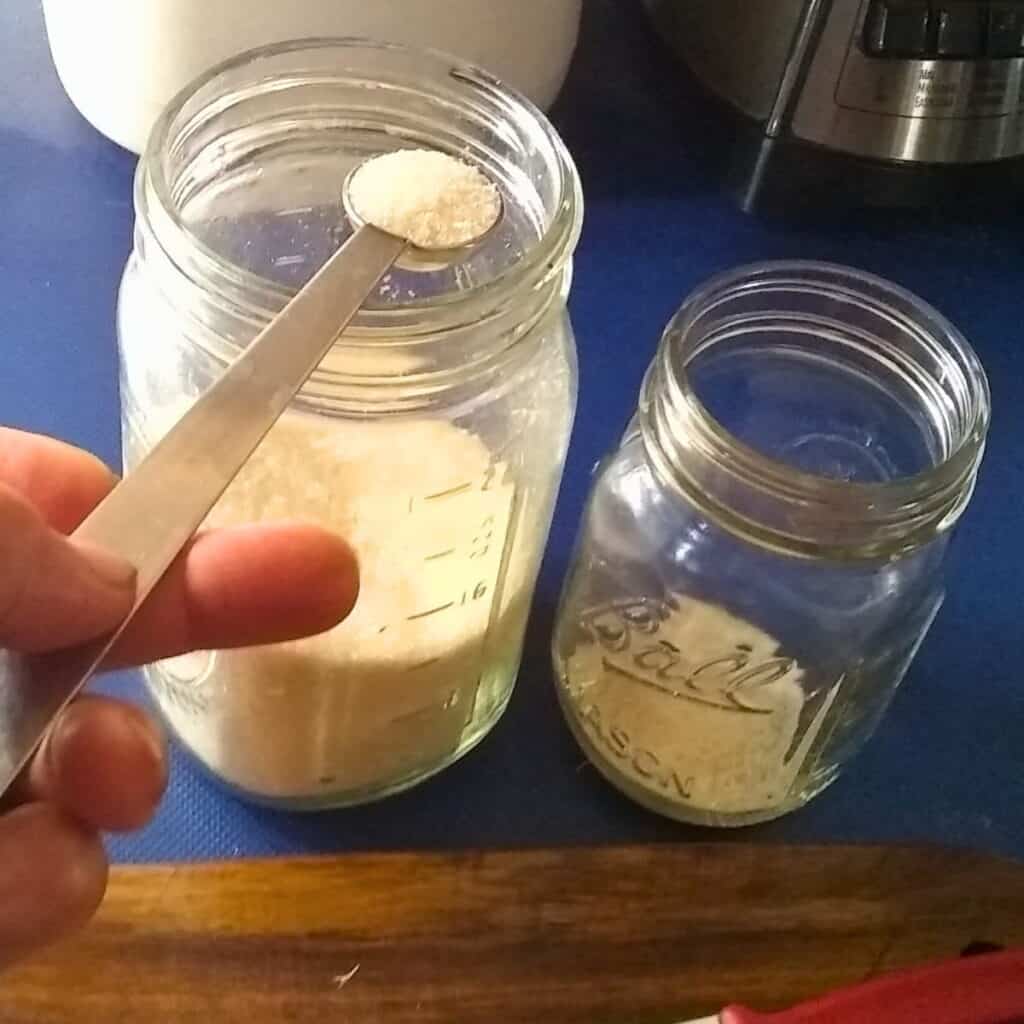
Measure out two teaspoons of sugar or other sweetener and put it into the jar.
Step 2 – thinly slice or dice your ginger root.

You can also grate it if you like. The important thing is to increase surface area. Do not wash or peel the root. You want to make use of the yeast that is present on the skin of the ginger.
Step 3 – measure out the ginger.

Measure out two teaspoons of the chopped or sliced ginger. Add ginger to the pint jar
Step 4 – Add water

Add your non-chlorinated water to fill the jar to about an inch from the top. Put the lid on the jar and place your ginger bug starter in a warmish, darkish corner, where you won’t forget about it. This is all for today. Start feeding tomorrow.
Days 2-6

Repeat steps 1-3 from Day 1. Just add two teaspoons of the ginger plus two teaspoons of sweetener to the ginger bug. Put the lid on and shake it up a bit to incorporate the sweetener. Repeat each day about the same time for 6 days.

Your ginger bug should be starting to show activity in the form of bubbling. She’s coming to life and is getting stronger. You’ve got a living ginger bug sitting on your counter now, take good care of that little critter.
Day 7

Now the fun part! Ginger bug should be all excited to brew some drinks for you now. You can make the awesome tasting and healthy ginger beer recipe that I provide on another post Best Ginger Beer. It provides step by step instructions on how to brew a great soda. These instructions work for many other flavors of soda too, so be sure to check it out.
I’ve got a list of flavoring ideas below for making your own sodas.
To use the ginger bug, strain and measure out half a cup of the ginger bug juice and set it aside to use in your preferred soda recipe. The rest of the bug needs to be fed again just the same as before, 2 teaspoons of ginger and 2 teaspoons of sweetener. Replace the water to fill the pint jar back to an inch below the top.
If you have too much ginger in your jar just take some out occasionally and use it in baking or cooking. I like to add it when I make my ginger beer syrup. After I use it up, it can go into the compost.
Day 8 to infinity

Keep feeding your bug and making sodas everyday if you like. If you need a break, you can put the ginger bug to rest in the refrigerator for a while. She’ll calm down and sleep there. Feed her once each week or two and keep her on the counter for a day to wake up. Then use her again or put her back into the fridge.
This can go indefinitely. Just try to give her periods of activity every now and then so she will remember what her job is.
This is all there is to starting and keeping a ginger bug. She’s a fun critter to have and she’ll make some sodas for you that will rock your socks off!
How to use this ginger bug recipe to make brewed sodas

Measure out your ginger bug juice
Now that your ginger bug is all active and ready to rock and roll, you can make some sodas. Measure out ½ cup of ginger bug juice and divide it between 4 pint bottles or canning jars.
Add flavored liquids
Add juice, or flavored water or tea with a bit of sugar, and if you like, a splash of lemon juice to fill the bottles, leaving a couple of inches of air space. Check out the list of flavoring ideas below.
Cap tightly
Place in a darkish, warmish corner
Let it activate for 24 hours in a warm place.
After a day, especially if it was hot out, you can burp the bottles to relieve some pressure. Do it carefully, as it’s possible that your contents will start foaming out of the bottle or even spray out. Replace cap and let it sit another day. It takes about two to three days to get a nice fizzy drink.
Chill your soda
You can take a taste test at the end of day two and if you like it, put it into the fridge to chill. If it’s too sweet or not fizzy enough, let it sit out another day.
Once you refrigerate it, the yeasts will rest and stop producing more carbonation, but it will still consume a bit of the sugar in your drink, making it less sweet after a few more days. I like it that way, because I don’t like my drinks very sweet. Just be aware of that.
One Important note of caution
Some caution is in place here. If your bottles aren’t meant for fermenting, they could break from the pressure that builds in the bottles. So be sure to use quality glass bottles for brewing, or canning jars. I like to re-use store bought kombucha bottles with silicone seal lids. They work great.
If you’re not sure about the bottles you’re using, try to ferment inside a box, so if they do break, the box will contain the mess is somewhat.
The fun part – choosing your flavorings for the ginger bug recipe

Below are a few ideas for flavorings, but don’t stop here. Let your imagination or your taste buds guide you and experiment. You are no longer limited to the few available flavors of store bought soda.
Add flavorings to the bottles at bottling time with your liquid ingredients. Do not add them to the ginger bug.
Juices
Use any juice either straight up or you can dilute it with water. Normally you would not have to add any more sweetener. Even unsweetened juice has quite a bit of natural sugar in it, and is much better for your health.
In the case of lemon juice or lime juice though, where you add just a dash or two to water, there is not really any sugar available to feed the yeasts. So you’ll have to add a teaspoon or more, depending on your preference for sweetness. This will basically make carbonated lemonade.
Juices can be just for flavoring, or for medicinal and health purposes if that is a concern for you. Try Elderberry, pomegranate, aronia, black cherry or blueberry juice just to name a few. Incorporate antioxidants and immune boosting properties into your soda to make it truly healthy.
Pineapple juice can help with digestion and prune juice will help with regularity. Grapefruit juice will add that bitter flavor and quercitin, and Ginger juice can add all the health benefits of ginger. Mix in some beet juice, or carrot juice for additional powerful health benefits.
I have also thought about trying to add grapefruit peel tea or extract (quercitin) or quinine for that tonic kind of flavor. I’ll update my post when I do to report on how I like it.
Teas and concoctions
Here you can use any herbal tea you like. Black tea, green tea, sarsaparilla, ginger, turmeric, dandelion, peppermint, lemon balm, echinacea, hibiscus, rosehip, self heal, mixed herbs, spice tea, elder or schisandra berries, reishi or chaga mushroom, etc. Mix for health benefits or for flavor. Simmer any roots, spices, mushrooms, berries and seeds for a few minutes and add the leafy herbs and flowers after simmering.
Add a little sweetener to feed the yeasts. Try two teaspoons per pint bottle or more to suit your taste. You can experiment with sweetness to find what your ‘sweet’ spot is.
Water
Use just water with a dash of bottled natural flavoring. Just be sure to add two or more teaspoons of sugar or honey to feed the yeast.
Your Questions Answered
What can I do with the ginger pieces when I have too Many in my ginger bug?
Just strain off the liquid into a fresh jar, feed as normal and use the ginger pieces in your strainer any way you like. Simmer it to make a tea (it will be sweet) or to make a syrup for your next batch of ginger-flavored sodas. Or just blend it straight out of the jar into a paste you can use for baking or freeze for later. Or dry it to grind into a powder you can use as a seasoning in cookies, smoothies, and quick breads.
Does Soda made from a Ginger Bug contain Alcohol?
The short answer is Yes! However it is minimal if you keep your fermentation time very short. I cover the alcohol content in fermented sodas in more depth in my dandelion bug article, head on over to get all the details.
Can I use frozen or dried ginger?
I have not tried to create a ginger bug from scratch with anything other than fresh ginger with skin on. You should try to find organic ginger, since often the good bacteria that we want for our ginger bug, which lives on the skin, has been killed by irradiation or chemicals to extend shelf life. It may also have herbicide residue on it from growing in conventional operations.
I do use organic dried ginger granules when I don’t have fresh available to feed the bug, but I have not used dried ginger to get the bug established. I feel that it does better with fresh ginger and so I try to use fresh when I can.
In my research, I found that people are using frozen ginger to feed the bug too, and it seems to work fine, but I don’t know if that will work when starting a bug from scratch. I know when I was trying to make wine from frozen strawberries, I could not get a fermentation going, which is normally never a problem with fresh ones. I did find one person reporting that frozen ginger did not work to start her ginger bug. So I assume that freezing might kill those bacteria that we need to get a fermentation started.
I would say, you should really try to get fresh, organic ginger to create and make your ginger bug come to live. If you can’t source organic fresh ginger locally, give Azure Standard a try. After it has matured and is strong, you might get away feeding it dried or frozen ginger.
Final Thoughts
As you can see, a ginger bug is very easy to start and it takes just a few days to get your starter for making sodas. Probiotic sodas are infinitely superior to the commercial grocery isle sodas. I don’t think that you can even compare the two except that they are both fizzy. With homemade brewed sodas, you’ll get a gut-healing drink that can support your immune system, offer probiotic bacteria to help with your digestive system and balance your gut microbiome. You’ll get vitamins, minerals and other nutrients, and depending on the ingredients in your sodas, you can even get extra health benefits such as when making a fizzy lemon soda or ginger beer! How awesome is that?!
Let me know in the comments below how you like the ginger bug and if you have experimented with her. What are your favorite soda flavors?
If you have any questions, leave me a comment! And I’ll do my best to answer quickly. Let me know how it went, if you’ve made this recipe, and how you are using fermented ginger paste!
Don’t forget to sign up for more recipes like this as well as homesteading tips and ideas and you’ll get notified by email as soon as I get new information posted!
Head on over to my article for making a fizzy lemonade and don’t miss my Best Ginger Beer Recipe to get detailed, step-by-step instructions on how to make a plain or flavored ginger beer from scratch, using the ginger bug. You can use the same method for root beer or any other flavors listed. Just be sure that there is a little sugar in your flavorings or water.
To learn about all the amazing health benefits of ginger, go to my post on Health Benefits Of Ginger Beer!
What to read next:
Probiotic Fermented Lemonade Soda -A refreshing fizzy soda that will cool you down on hot days and support your gut health!
Dandelion Bug recipe An alternative to ginger bug if you’d rather use a local, foraged source for your soda starter culture. Dandelion root works fantastic for making healthy homemade sodas!
Ginger Beer Recipe: fizzy, delicious, healthy! Create your own non-alcoholic ginger beer from scratch, using ginger bug. Customize with your favorite add-ons. Enjoy a fizzy summer drink that is so much better in taste and for your body, than grocery aisle soda.
Health benefits of ginger beer Learn all about the awesomeness of ginger. Health benefits you can gain for your body when you include this versatile plant into your daily health regimen. Improve your well being get healing with many chronic issues.
Switchel Recipe – A refreshing electrolyte drink for hydration during summer activities.
Healthy ginger ale recipe. This is so refreshing and very quick and easy to make on a hot day. Homemade is so much better for you too!
How To Grow Ginger At Home – All about growing ginger from start to harvest. Grow it in the garden, greenhouse, or in pots. Plus how to store or preserve ginger, and how to use it.
Fermented Turmeric Paste – Make this convenient fresh turmeric paste for your wellness and as a convenient seasoning for your curries and other foods. Turmeric has so many benefits, find out all about it and why fermenting it makes it even better.
Fermented Ginger Honey – Keep this potent fermented health food on hand. Use the powers of Ginger and Honey in a tasty syrup form that you’ll love.

Ginger Bug Recipe
Equipment
- 1 pint jar with lid
- 1 measuring teaspoon
- 1 funnel
- 1 strainer
- 1 cutting board
- 1 knife
- 4 pint size brewing bottles or canning jars
Ingredients
- 1 large organic ginger root
- 2 tsp natural organic cane sugar or honey
- 2 cups filtered, non-chlorinated water
Instructions
- Day 1Step 1 – thinly slice your ginger root. You can also dice it or grate it if you like. The important thing is to increase surface area. Do not wash or peel the root. You want the yeast that is present on the skin of the ginger.Step 2 – measure out the ginger. Measure out two teaspoons of chopped ginger. Place the ginger into a pint jar.Step 3 – add sweetener. Measure out two teaspoons of sugar or other sweetener and add it to the ginger in the jar.Step 4 – Add water. Add your non-chlorinated water to fill the jar to about an inch from the top. Put the lid on the jar, shake it to mix, and place your ginger bug starter in a warmish, darkish corner, where you won't forget about it. Start feeding tomorrow.
- Days 2-6Repeat steps 1-3 from Day 1. Just add two teaspoons of the ginger root plus two teaspoons of sweetener to the ginger bug. Put the lid on and shake it up a bit to incorporate the sweetener. Repeat each day about the same time for 6 days. Your ginger bug should be starting to show activity in the form of bubbling.
- Day 7Ginger bug should be mature enough for brewing. You can now make the awesome tasting and healthy ginger beer recipe that I provide on another post Best Ginger Beer. It has step by step instructions on how to brew a great soda. These instructions work for many other flavors of soda too, so be sure to check it out.To use the ginger bug, strain and measure out half a cup of the ginger bug water and set it aside to use in recipes. The rest of the bug needs to be fed again just the same as before, 2 teaspoons of ginger and 2 teaspoons of sweetener. Replace the water to fill the pint jar back to an inch below the top. If you have too much ginger in your jar just take some out occasionally and chew it or use it in baking or cooking. I like to add it when I make my ginger beer syrup. When it's used up, it can go into the compost.
- Day 8 to infinityKeep feeding your bug and making sodas everyday if you like. If you need a break, you can put the ginger bug to rest in the refrigerator for a while. She'll calm down and sleep there. Feed her once each week or two and keep her on the counter for a day to wake up and eat. Then use her to make soda, or put her back into the fridge. This can go indefinitely. Just try to give her periods of activity every now and then so she will remember what her job is.
Notes
How to use your ginger bug to make brewed sodas
Measure out your ginger bug juice
Now that your ginger bug is all active and ready to rock and roll, you can make some sodas. Measure out ½ cup of ginger bug juice and divide it between 4 pint bottles or canning jars (2 tablespoons per pint)Add flavored liquids
Add juice, or flavored water or tea with 1-2 Tb of sugar, and if you like, a splash of lemon juice to fill the bottles, leaving 1 inch of air space. Then cap tightly.Place in a darkish, warmish corner
Let it ferment for 48 – 36 hours in a warm place. After a day, you can burp the bottles to relieve some pressure. Do it carefully, as it’s possible that your contents will start foaming out of the bottle or even spray out. Replace cap and let it sit another day. It takes about two to three days to get a nice fizzy drink. In a very warm room it goes faster.Chill your soda
You can take a taste test at the end of day two and if you like it, put it into the fridge to chill. If it’s too sweet or not fizzy enough, let it sit out another day. Once you refrigerate it, the yeasts will rest and stop producing more carbonation, but it will still consume a bit of the sugar in your drink, making it less sweet after a few more days. I like it that way, because I don’t like my drinks very sweet. Just be aware of that.One note of caution
Some caution is in place here. If your bottles aren’t meant for fermenting, they could break from the pressure that builds in the bottles. So be sure to use quality glass bottles for brewing or canning jars. I like to re-use store bought kombucha bottles with silicone seal lids. They work great. If you’re not sure about the bottles you’re using, try to ferment inside a box, so if they do break, the mess is somewhat contained.Flavorings
Below are a few ideas for flavorings, but don’t stop here. Let your imagination or your taste buds guide you and experiment. You are no longer limited to the few available flavors of store bought soda. Add flavorings to the bottles at bottling time with your liquid ingredients. Do not add them to the ginger bug.Juices
Any juice can be used either straight up or diluted with water. Normally you would not have to add any more sweetener. In the case of lemon juice or lime juice though, where you add just a dash or two to water, there is not really any sugar available to feed the yeasts. So you’ll have to add a couple of teaspoons or more, depending on your preference for sweetness. This will basically make carbonated lemonade.Juices can be just for flavoring, or for medicinal and health purposes.
Incorporate antioxidants and immune boosting properties into your soda to make it truly healthy. Try Elderberry, cranberry, pomegranate, aronia, black cherry or blueberry juice just to name a few. Pineapple juice can help with digestion and prune juice will help with regularity. Ginger juice can add all the health benefits of ginger. Mix in some beet juice, or carrot juice for more powerful health benefits.Teas and concoctions
Here you can use any herbal tea you like. Black tea, green tea, sarsaparilla, ginger, turmeric, dandelion, peppermint, lemon balm, echinacea, hibiscus, rosehip, spice tea, elder- or schisandra berries, reishi or chaga mushroom, etc. Mix for health benefits or for flavor. Simmer any roots, spices, mushrooms, berries and seeds for a few minutes and add the leafy herbs and flowers after simmering. Add a little sweetener to feed the yeasts. Try two teaspoons per pint bottle or more to suit your taste. You can experiment with sweetness to find what your ‘sweet’ spot is. If I simmer a brew, I use ⅓ cup of cane sugar in 8 cups of water.Lemonade
Mix 2 Tb of cane sugar with a little hot water to dissolve the sugar, add 2 Tb of fresh lemon juice, fill with filtered water and ferment for 2-3 days.Water
Use plain water with a dash of natural flavoring. Just be sure to add a couple of teaspoons of sugar or honey to feed the yeast.Where to get ingredients:
Organic fresh ginger root Organic bottled lemon juice Organic lime juice Ginger juice Grolsch type bottles Evaporated cane juice Panela, sucanat Coconut sugar HoneyShop this post
Berkey filter
Reeds Premium Ginger Ale
Organic fresh ginger root
Organic bottled lemon juice
Organic lime juice
ginger juice
Grolsch type bottles
Evaporated cane juice
Sucanat (Panela sugar, jaggery)
Coconut sugar
Maple syrup
Fresh Organic Ginger – get organic ingredients at Azure Standard. This is a buyer’s club that offers drops all around the country. Find a drop near you, sign up and get lots of organic foods delivered once a month by truck! Highly recommended.
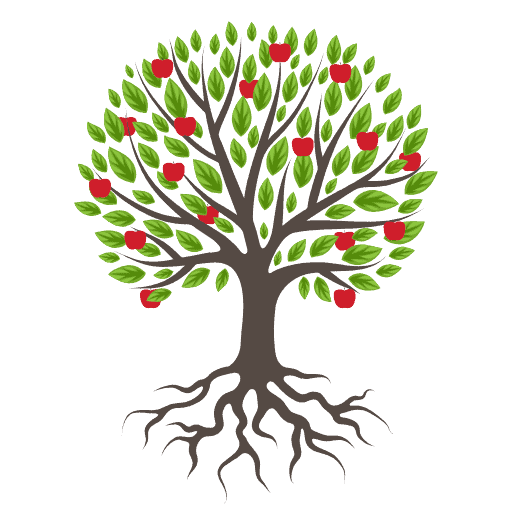
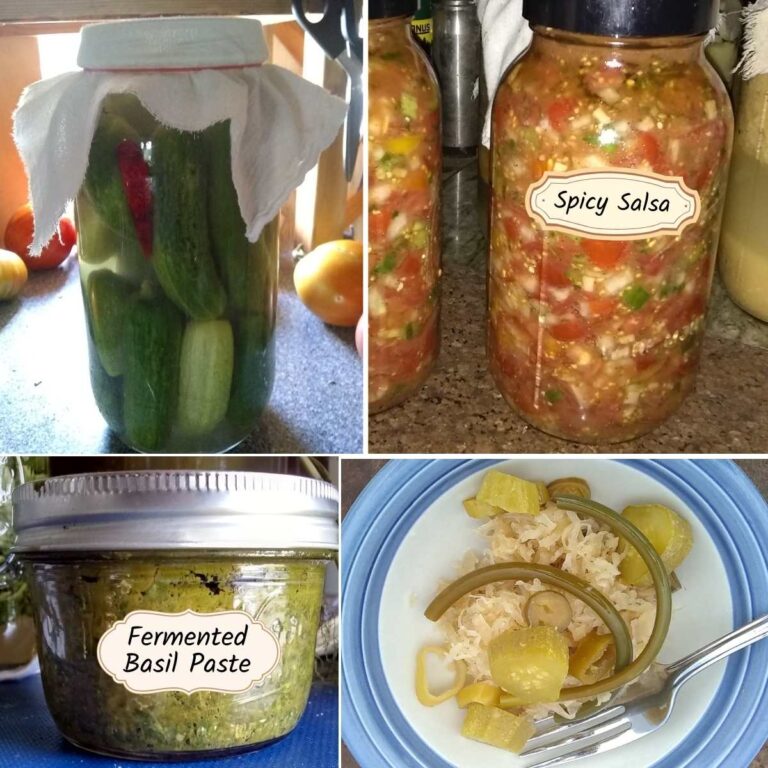



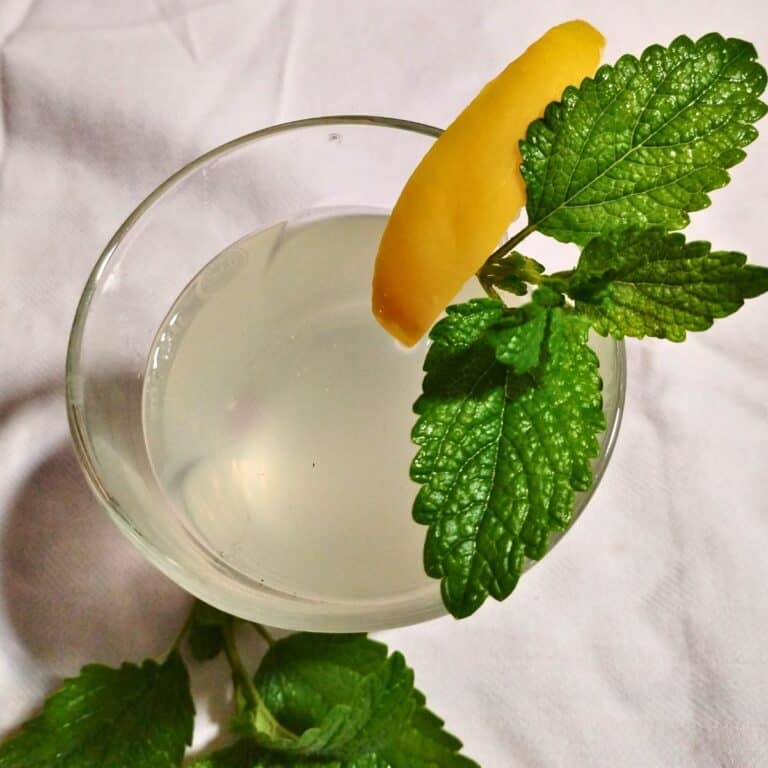
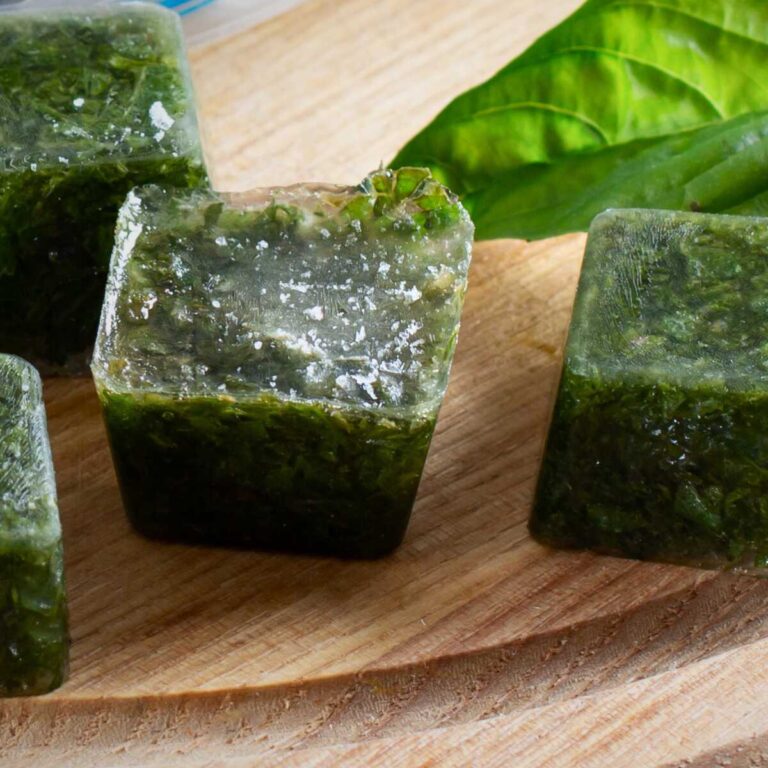
I love my exciting fizzy sodas with this home-grown, lively ginger bug! I don’t let the summer heat get to me! With refreshing probiotic sodas in the fridge I can hydrate and improve my health all at the same time! Awesome deal!
This is simply fascinating and sounds lovely. I love ginger and I can’t wait to try this recipe! I’m adding this to my “new things I wanna try this week” list lol, thanks so much for sharing all your knowledge!
That’s awesome, I think you’ll love it and I’d love to hear about what awesome sodas you will make!
Aha! This ginger bug guide is step 1 for the homemade fizzy lemonade you mentioned. So cool!
Yep, that’s it. If you have a starter, you can get creative with sodas, it really is fun!
Hi, i made this ginger bug about a week and a half ago, and it seems to be going great, but when I tried to make the fizzy lemonade, it did absolutely nothing. I used honey as the sweetener in the lemonade portion only and had used palm sugar in the bug. Could the honey be the problem?
Hello Greta! I’m glad you got to try this and that your ginger bug is working out and alive. Honey can slow fermentation a bit, but maybe you need to just wait another day or two. I would try making another batch with the palm sugar instead of the honey to see if that works better. If your ginger bug is lively, it should work to make your lemonade. Be sure to add enough sweetener to give those microbes the food they need, and that your temperature for fermenting is in a good range, 72-85 degrees is best. And the water needs to be chlorine free. Also be sure that your bottle is tightly capped so no gasses can escape. Sometimes it takes 2-3 days to get some fizz. I hope this helps!